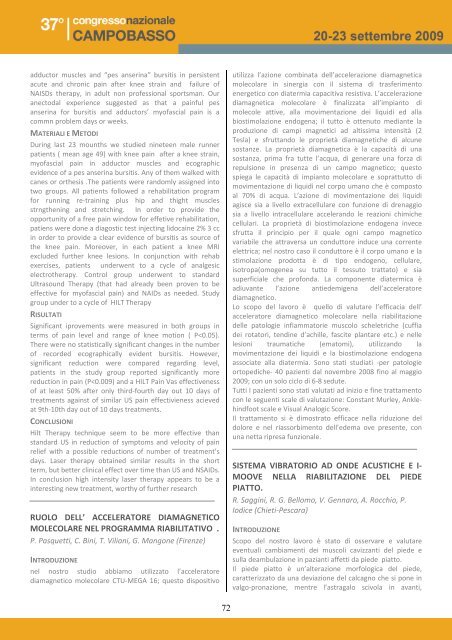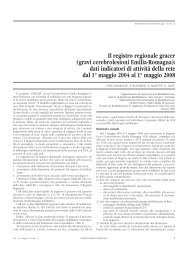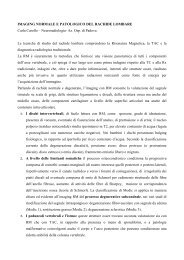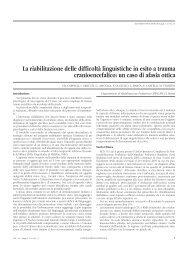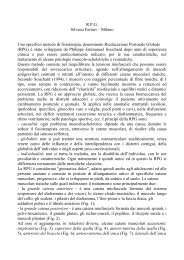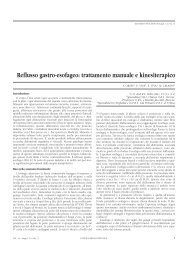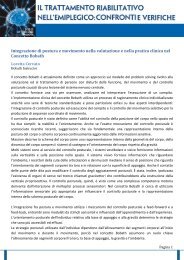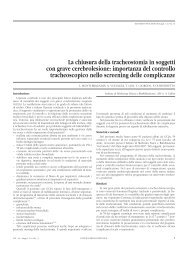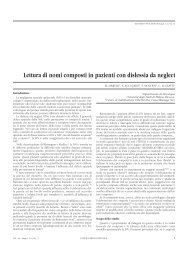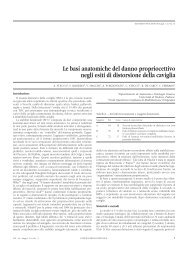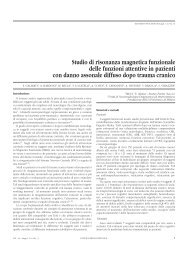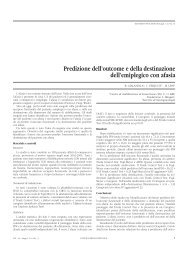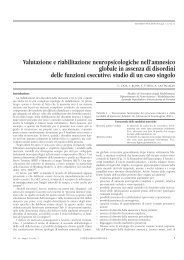- Page 1 and 2:
BOOK ABSTRACT Presidente del Congre
- Page 3 and 4:
INDICE ICF 15 CONOSCENZE E ASPETTAT
- Page 5 and 6:
LOMBARDIA: CRITICITA’ DOPO IL PRI
- Page 7 and 8:
DALLA CARTELLA CLINICA INTEGRATA AI
- Page 9 and 10:
RIABILITAZIONE ONCOLOGICA 133 DISAB
- Page 11 and 12:
IL TRATTAMENTO CON ONDE D’URTO NE
- Page 13 and 14:
VALUTAZIONE FUNZIONALE DEI DISTURBI
- Page 15 and 16:
EFFICACIA DEI MAGNETI QUADRIPOLARI
- Page 17 and 18:
interpersonali è compromessa in me
- Page 19 and 20:
salienti categorie dell’ICF relat
- Page 21 and 22: La versione tradotta in italiano de
- Page 23 and 24: scheletro assile ed appendicolare.
- Page 25 and 26: STUDIO CLINICO RANDOMIZZATO IN DOPP
- Page 27 and 28: di risultati preliminari, anche per
- Page 29 and 30: • Il Risultato finale nel gruppo
- Page 31 and 32: p=0,0001) ad indicare una significa
- Page 33 and 34: Presso il nostro presidio ospedalie
- Page 35 and 36: di questa dolorosa sindrome. Il nos
- Page 37 and 38: ASPETTI TERAPEUTICI E RIABILITATIVI
- Page 39 and 40: Scopo: dimostrare la validità psic
- Page 41 and 42: selezionando soggetti aventi un’e
- Page 43 and 44: di lavoro spazi ricreativi per i pr
- Page 45 and 46: GRAVI CEREBROLESIONI ACQUISITE APPR
- Page 47 and 48: I SISTEMI ROBOTIZZATI NEL TRATTAMEN
- Page 49 and 50: MATERIALI E METODI Impiegando 2 que
- Page 51 and 52: La PRIMA FASE è quella della presa
- Page 53 and 54: PREVENZIONE DELLE INFEZIONI CORRELA
- Page 55 and 56: Sono stati individuati pazienti con
- Page 57 and 58: possono presentarsi, in questi sogg
- Page 59 and 60: JOINT SESSION SIMFER-SIRN APPROCCIO
- Page 61 and 62: significativo incremento del potere
- Page 63 and 64: *p = 0.001; **p =
- Page 65 and 66: Trattamento gruppo di controllo: Tr
- Page 67 and 68: influenza le capacità a riprendere
- Page 69 and 70: Sicuramente i risultati presentati
- Page 71: LA LASERTERAPIA ASSOCIATA A TRAININ
- Page 75 and 76: extracellulare (ECM) o che sono gen
- Page 77 and 78: RIABILITAZIONE PERSONA MIELOLESA
- Page 79 and 80: toracica e il volume del compartime
- Page 81 and 82: un’indubbia influenza sulla riduz
- Page 83 and 84: dovrebbe essere enfatizzata per pre
- Page 85 and 86: seduta con un buon controllo del tr
- Page 87 and 88: indicazioni di igiene comportamenta
- Page 89 and 90: metabolica possano essere di estrem
- Page 91 and 92: MATERIALI E METODI Abbiamo utilizza
- Page 93 and 94: INTEGRAZIONE OSPEDALE- TERRITORIO A
- Page 95 and 96: Nell’ottica della continuità di
- Page 97 and 98: lieve: minore efficienza nell’aff
- Page 99 and 100: frequenti nel mondo sanitario pubbl
- Page 101 and 102: sia in regime di ricovero che di da
- Page 103 and 104: I RISULTATI RAGGIUNTI CON LA TECNIC
- Page 105 and 106: spesso asintomatica nelle fasi iniz
- Page 107 and 108: PROBLEMATICHE DELLA TERZA E QUARTA
- Page 109 and 110: Il 37,9% dei soggetti ha usufruito
- Page 111 and 112: Questa attività è stata possibile
- Page 113 and 114: cedimenti vertebrali su base osteop
- Page 115 and 116: ANALISI DEL MOVIMENTO ANALISI CINEM
- Page 117 and 118: cerebrolesione, reazioni associate
- Page 119 and 120: includente le scale WOMAC e NRS, va
- Page 121 and 122: osteoporosi presentano un assetto p
- Page 123 and 124:
2) miglioramento della sintomatolog
- Page 125 and 126:
DEFINIRE GLI OUTCOMES IN RIABILITAZ
- Page 127 and 128:
INTRODUZIONE Con il nostro lavoro v
- Page 129 and 130:
Pertanto, accanto alla “semplice
- Page 131 and 132:
soddisfacente con il punteggio alle
- Page 133 and 134:
altamente significativi eccezion fa
- Page 135 and 136:
the immediate complications in the
- Page 137 and 138:
CONCLUSIONI Sono ben note da tempo
- Page 139 and 140:
una sempre più stretta collaborazi
- Page 141 and 142:
TRAUMATOLOGIA E PROTESICA ARTICOLAR
- Page 143 and 144:
del soggetto, sia quelle preesisten
- Page 145 and 146:
Nel post‐operatorio i momenti fle
- Page 147 and 148:
TERAPIA BIOFISICA CON I‐ONE* DOPO
- Page 149 and 150:
INTRODUZIONE Dall’ analisi della
- Page 151 and 152:
STROKE APPLICAZIONE DI UN PROTOCOLL
- Page 153 and 154:
conservazione del Potenziale Evocat
- Page 155 and 156:
‐ ritardo nell’accoglimento in
- Page 157 and 158:
L’analisi degli intervalli di att
- Page 159 and 160:
MATERIALI E METODI Sono state valut
- Page 161 and 162:
INTRODUZIONE Da più parti vi sono
- Page 163 and 164:
Obiettivo dello studio è l’anali
- Page 165 and 166:
INTRODUZIONE Si presentano gli ulte
- Page 167 and 168:
JOINT SESSION SIMFER-SIUD SULLA RIE
- Page 169 and 170:
prestazioni ambulatoriali, e coinvo
- Page 171 and 172:
controverse informazioni circa il s
- Page 173 and 174:
I nostri dati preliminari sono rife
- Page 175 and 176:
maxillo‐facciale, ortopedia e med
- Page 177 and 178:
sportivi queste fratture sono molto
- Page 179 and 180:
dopo una, quattro, dodici e ventiqu
- Page 181 and 182:
In particolare nel confronto caso
- Page 183 and 184:
TECNOLOGIA INNOVAZIONE E RICERCA AP
- Page 185 and 186:
Nel nostro campione i fattori deter
- Page 187 and 188:
INNOVARE IN RIABILITAZIONE:UNA NUOV
- Page 189 and 190:
1.2 Struttura 1 1 14 18 22 16 1.3 F
- Page 191 and 192:
settimana per un periodo di 2 setti
- Page 193 and 194:
RIABILITAZIONE DELL’EMIPLEGICO CO
- Page 195 and 196:
Il Lokomat ed il ReoAmbulator appar
- Page 197 and 198:
Extremity Skill Test, organizzando
- Page 199 and 200:
INTRODUZIONE Con l’invecchiamento
- Page 201 and 202:
adiografia in proiezione laterale d
- Page 203 and 204:
NEUROLESIONI IN ETÀ EVOLUTIVA APPL
- Page 205 and 206:
modificabile attraverso l’utilizz
- Page 207 and 208:
RELAZIONE TRA DEFICIT DI FORZA IN F
- Page 209 and 210:
incentrati sul recupero funzionale
- Page 211 and 212:
DISORDINI COGNITIVI IN PAZIENTI AFA
- Page 213 and 214:
suddivisi in 3 liste diverse e cias
- Page 215 and 216:
Concludendo dallo studio pilota eff
- Page 217 and 218:
comunicazione si è provveduto alla
- Page 219 and 220:
l’aspetto motorio (FM). La Btx‐
- Page 221 and 222:
la storia della PCI, se non trattat
- Page 223 and 224:
ostetriche,malattie congenite,ritar
- Page 225 and 226:
RACHIALGIA E PARADISMORFISMI AFA MA
- Page 227 and 228:
a valutazione statistica consideran
- Page 229 and 230:
delle semisfere in lattice di diver
- Page 231 and 232:
VALUTAZIONE FUNZIONALE E DIAGNOSTIC
- Page 233 and 234:
27 ratti maschi Sprague‐Dawley di
- Page 235 and 236:
anca totale e 12 operati con artrop
- Page 237 and 238:
QUALE SETTING RIABILITATIVO PER IL
- Page 239 and 240:
La comorbilità cardiaca è uno sta
- Page 241 and 242:
Il punto di partenza è stato ovvia
- Page 243 and 244:
individuale con gli specifici progr
- Page 245 and 246:
TRIAL CLINICO CONTROLLATO RANDOMIZZ
- Page 247 and 248:
MEDICINA MANUALE ASIMMETRIA RICORRE
- Page 249 and 250:
sembrano confermare che un trauma d
- Page 251 and 252:
PROPOSTA DI LINEE GUIDA IN MEDICINA
- Page 253 and 254:
Per entrambi i gruppi, il trattamen
- Page 255 and 256:
METODO:Maschio,anni 30,vittima di d
- Page 257 and 258:
otulea e quadricipitale sulla funzi


